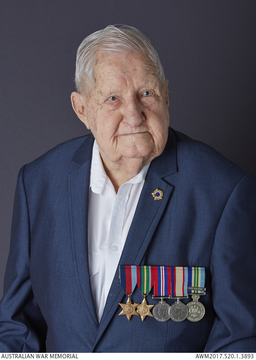CRANE, Frederick Gordon
| Service Numbers: | V64752, VX66408 |
|---|---|
| Enlisted: | 20 March 1941 |
| Last Rank: | Private |
| Last Unit: | 7 Infantry Battalion AMF |
| Born: | SWAN HILL, VIC, 5 May 1918 |
| Home Town: | Not yet discovered |
| Schooling: | Not yet discovered |
| Occupation: | Not yet discovered |
| Memorials: | Ballarat Australian Ex-Prisoners of War Memorial |
World War 2 Service
| 20 Mar 1941: | Enlisted Australian Military Forces (WW2) , Private, V64752, 7 Infantry Battalion AMF | |
|---|---|---|
| 9 Dec 1941: | Enlisted Australian Military Forces (WW2) , Private, VX66408 | |
| 9 Dec 1941: | Discharged Australian Military Forces (WW2) , Private, V64752, 7 Infantry Battalion AMF | |
| 26 Nov 1946: | Discharged Australian Military Forces (WW2) , Private, VX66408 |
Fred's War Story
I was in the Army as a 17 year old before the war, and I was 21 years old when the war broke out (in 1939). A whole bunch of us who were in the Army Reserves went down to Melbourne to the Caulfield Race Course to enrol the day after war was declared. Because I had problems with my eye, I was sent to Seymour to teach soldiers how to drive trucks.
In May, June and July of 1941 I underwent my compulsory training and following this I was sent to Bacchus Marsh with the 39th Battalian and taught them about trucks. I was told that I could join the 39th and go to New Guinea, but instead I joined the AIF in October. It was lucky that I did join the AIF because the 39th were the ones who ended up on the Kokoda Trail.
I arrived in Darwin on Christmas Day in 1941 to work for the Navy. My job was to work on the wharves with the freight. In January 1942 we all left Darwin, but we didn't know where we were going.
We escorted another "duck" ship (The Bantam) back to Ambon in February 1942.
Us 6 Army guys and 2 sailors were unloading the Bantam when Japanese troops (30,000!!!!) "came over the back of the hill".
Before the Japanese got to us, the Gull Force picked us up and took us with them to the end of the Island. There were about 1200 men in the Gull Force at this time.
The Japanese got us and marched us to Tantooi which became the Gull Force POW camp on February 4 1942. A few days later, the Japanese told us that we had to work to keep fit so we cut grass, unloaded ships, dug tank traps and ended up carting ammunition for the next 3 1/2 years.
The night we were captured we were so scared.
A few weeks before the war finished I escaped from the camp, I went under the barbed wire in the night time with 2 other blokes, Fred Schaffer, and Jimmy Elmore. We all split up. The Japanese caught Fred and executed him - his death featured in one of the war trials that they held after the war, while poor Jimmy died of Malaria in the jungle. I walked into a village after establishing that there were no Japanese there and I met up with a bloke called Jon Gasmus who ended up owning a garage on the Island.
Towards the end of the war we were all put to work building an enormous pit behind the air field. This was to have been our grave but fortunately the war ended before the Japanese got a chance to get rid of us.
Out of the 1200 men from the original Gull Force there were 120 left when we were finally rescued, and two of them died on the way back to Moratai, on the way home.
In September 1945 we were rescued by the HMAS Kootamundra and I spend 2 months on the Hospital ship, HMAS Wanganella which went home via Borneo and Moratai. The Allies only knew that we were on the Island because one of the surviving prisoners had been able to keep a telegraph hidden and the codes that this prisoner had tapped out were 'old' ones that hadn't been used since 1942. I saw a couple of sailors coming up the hill and they wanted me to get on a stretcher to go the ship but I told them 'I walked in here, I'll walk out'.
I got back to Heidelberg Repatriation Hospital and the first thing I did when I got there was walk around the whole hospital grounds to make sure that I knew how I could get out.
Submitted 9 April 2025 by Marenna Zeller










